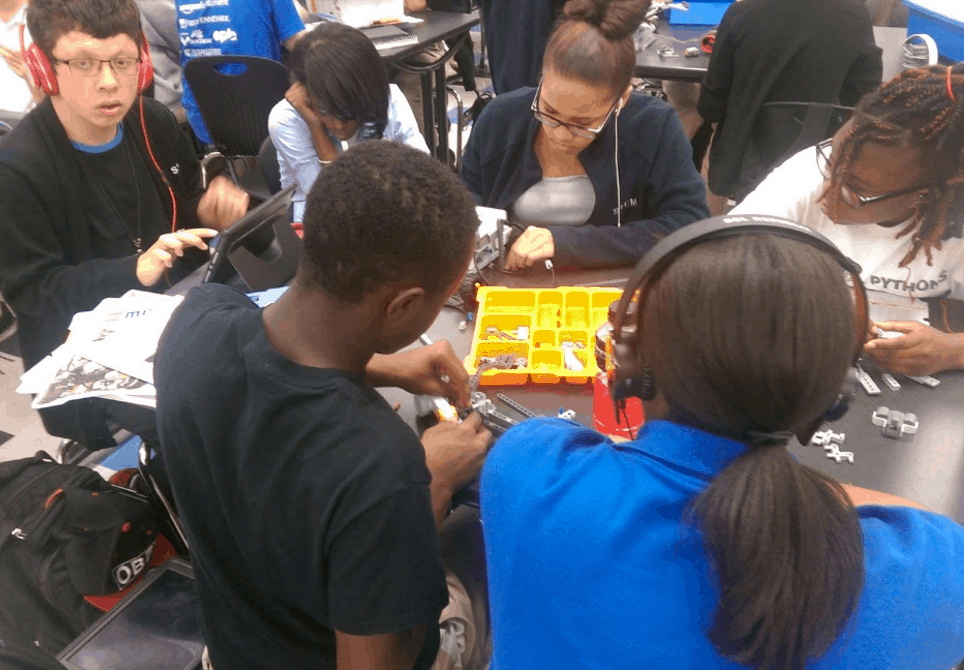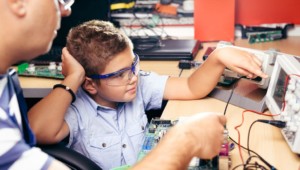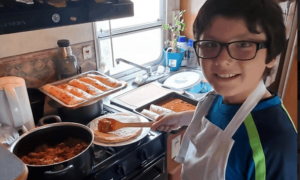Taking PBL One Step at a Time

By Tony Donen
One of my first meetings after accepting a job for my current principal placement at STEM School Chattanooga went something like this:
Me: “Throughout the interview process I was told several times that this high school is supposed to implement PBL. I have done some research on PBL and was wondering if the district was interested in project-based learning or problem-based learning. Which is the method the district would like to see implemented?”
After an awkward silence, which seemed to last forever but probably lasted closer to ten seconds, one of the folks in the room said, “that.”
Ever since that day, I have wondered how often teachers have been through a similar experience. Someone, an administrator, an educational guru or even a fellow teacher has said to them: “You should do PBL.”
Just do PBL, right?
As if it were that easy. It is not. Is PBL worth the change for students? Absolutely. But it’s not something anyone can be told and go in the next day of school and just do. However, there are several things that can be done to prepare teachers to become strong PBL implementers.
Almost complete! 10th grade @STEMcha students testing their project for their PBL final presentation! #STEM pic.twitter.com/M9KoGHawJv
— STEM HS Chattanooga (@STEMcha) October 6, 2016
Start Small
To understand and implement PBL well, a teacher must learn how to set the stage and create an environment where students ask questions, seek out information and find various solutions. In a typical lesson, students ask questions when prompted, wait for the teacher to provide the information and everyone works toward the same one solution. The paradigm shift from a typical lesson environment to a PBL type environment is the foundational stage for a teacher to begin
The paradigm shift from a typical lesson environment to a PBL type environment is the foundational stage for a teacher to begin the journey of PBL work. It is important to note that the teacher does not have to start with full-fledged PBL to implement this environment. An excellent resource for designing this setup can be found in the SOLE approach – a Self-Organizing Learning Environment.
This approach is not difficult to learn, does not require hours of training and can be planned in a very short amount of time. In this approach, the teacher sets a big question for students to answer, sets the students off in finding information to build out their answer, allows students to move among groups to see what others are finding and creating and requires students to present out their ideas and solutions as the capstone to the lesson.
Find Your Peers
Once a teacher becomes more comfortable with the student-centered classroom environment described above, it is now time for the teacher to find peers. The goal is for a teacher to find other teachers and educators that either want to pursue PBL initiatives or are already implementing PBL.
It is important for a teacher not to be isolated in the PBL learning process. Every teacher needs at least one person who they can bounce ideas off of around their PBL work. Why? High-quality quality PBL implementation requires collaborative efforts among students. If the teacher is not trying to work collaboratively, it is very difficult for the teacher to empathize with the students. Great collaboration among students is not by chance.
Develop Your PBL Content Knowledge
What is in a great PBL plan and why include it? Teachers who cannot answer this question (especially the ‘why’ piece) need to build understanding of the parts included in PBL. There are several ways to build this piece. The obvious is research PBL online–a teacher can find hundreds of sites.
My preferred method: find a PBL training for the teacher to attend where participants build a PBL plan throughout the training. The key is to avoid attending trainings that provide a PBL overview and instead make sure to find trainings where the teacher creates a PBL unit. There are more than several training groups in this arena. A few organizations I believe have quality PBL training include Buck Institute for Education, devX PD and ARIE – Advanced Reasoning in Education.
Plan, Plan, Plan
Great PBL is a result of great planning. Planning for PBL is very different from planning for a traditional lesson. Teachers should have a template of the items that need to be planned out for a PBL implementation. Items that I use as my holy grail for PBL templates include detailing the driving question, hook event, scaffolding activities, calendar, common assessment rubric and culminating event. Teachers must have a template they use and plan each of these pieces out before the first day of implementing PBL.
The most challenging and important piece to the planning process is the common assessment rubric. Teachers need to provide this rubric to students on the front end of PBL work because it sets the expectation and quality for student PBL products. This is the one piece in the planning process that teachers must have someone else review. It can be an administrator, a colleague, a peer online–just be sure to have another educator review it.
The goal of the review is to help the teacher have a clear rubric that students understand and one that has high expectations for the quality of student work. Examples of PBL plans, in both single subject areas and cross-curricular units, can be found under PBL – Curriculum Units for STEM School Chattanooga.
PBL Scaffolding Activities
Once a teacher is at this point, the implementation of PBL in the classroom is reliant on the day-to-day scaffolding activities. Teachers who seek out other educators to observe their PBL implementation and provide feedback on the scaffolding activities are the teachers who grow the fastest. These are activities that can be used throughout the PBL process. Activities that I endorse and have found to be the most beneficial include:
Class Activities. These are full class activities where the teacher wants everyone to participate at the same time.
Station Activities. These are full class activities where the teacher wants everyone to participate, but the teacher does not need everyone to participate at the same time. It is a station (center) in the classroom.
Workshops. These are optional activities for a small group of students at a station. Workshops can be based on information a teacher believes will be helpful or the workshop can be requested by students. Workshops can be teacher and/or student created and led.
Focus Groups. This is mandated small group time with the teacher for students who need help in basic skills and knowledge.
PBL Teams. Should include a very brief description of the PBL team makeup and describe any miscellaneous items that are used in the group dynamics (like a student contract).
Digital Resources. Include any digital resources that are not already highlighted in a category above, but are useful resources for PBL students.
Every PBL Experience is Another Prototype
The final piece in teacher development for PBL relies on prototyping. Prototyping is the process of building something small, testing it, revising it, growing it, testing it, revising it, growing it, etc, etc, etc.. Teachers often have a strong fear of failure and are conditioned to judge items as successes or failures. Prototyping is not about success and failure. Prototyping is about continuous improvement.
Teachers can learn this prototyping process through other activities like the marshmallow challenge. The best project-based learning experiences are not judged as a success or failure in the initial implementations. They are considered as prototypes in a continuous improvement process.
For teachers, administrators and schools that focus on developing teachers along this professional development pathway, teachers will grow tremendously and the classroom experience for students will forever be changed positively.
Tony Donen is the Principal at STEM School Chattanooga. You can follow him at @tonydonen and read his blog TD Talks Education.
|
This blog is part of “It’s a Project-Based World” series. To learn more about this series and to learn ways that you can contribute, click the icon below to go to the Project-Based World page. Join in the conversation at #projectbased. |
For more, see:
- The Ripple Effect: Creating Community Change through Schools
- 3 Teacher Tips for the PBL Paradigm Shift
- 35 Leaders on the Successes and Challenges of Project-Based Learning
Stay in-the-know with all things EdTech and innovations in learning by signing up to receive the weekly Smart Update. This post includes mentions of a Getting Smart partner. For a full list of partners, affiliate organizations and all other disclosures please see our Partner page.






Ed
Tony, where are good resources on PBL and building teen vocabulary?